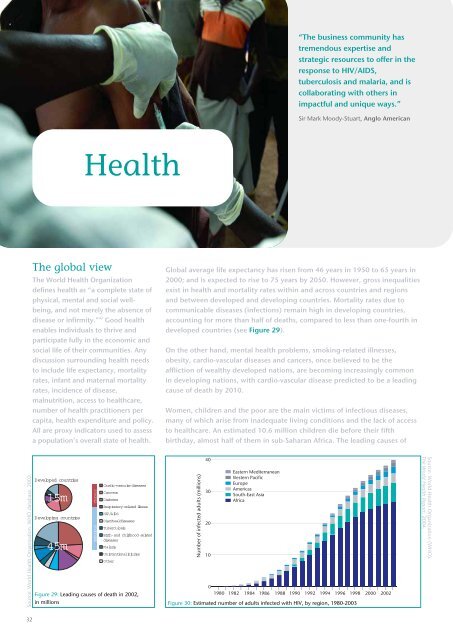“The business community hastremendous expertise andstrategic resources to offer in <strong>the</strong>response to HIV/AIDS,tuberculosis and malaria, and iscollaborating <strong>with</strong> o<strong>the</strong>rs inimpactful and unique ways.”Sir Mark Moody-Stuart, Anglo AmericanHealthThe global viewThe <strong>World</strong> Health Organization<strong>de</strong>fines health as “a complete state ofphysical, mental and social wellbeing,and not merely <strong>the</strong> absence ofdisease or infirmity.” 42 Good heal<strong>the</strong>nables individuals to thrive andparticipate fully in <strong>the</strong> economic andsocial life of <strong>the</strong>ir communities. Anydiscussion surrounding health needsto inclu<strong>de</strong> life expectancy, mortalityrates, infant and maternal mortalityrates, inci<strong>de</strong>nce of disease,malnutrition, access to healthcare,number of health practitioners percapita, health expenditure and policy.All are proxy indicators used to assessa population’s overall state of health.Global average life expectancy has risen from 46 years in 1950 to 65 years in2000; and is expected to rise to 75 years by 2050. However, gross inequalitiesexist in health and mortality rates <strong>with</strong>in and across countries and regionsand between <strong>de</strong>veloped and <strong>de</strong>veloping countries. Mortality rates due tocommunicable diseases (infections) remain high in <strong>de</strong>veloping countries,accounting for more than half of <strong>de</strong>aths, compared to less than one-fourth in<strong>de</strong>veloped countries (see Figure 29).On <strong>the</strong> o<strong>the</strong>r hand, mental health problems, smoking-related illnesses,obesity, cardio-vascular diseases and cancers, once believed to be <strong>the</strong>affliction of wealthy <strong>de</strong>veloped nations, are becoming increasingly commonin <strong>de</strong>veloping nations, <strong>with</strong> cardio-vascular disease predicted to be a leadingcause of <strong>de</strong>ath by 2010.Women, children and <strong>the</strong> poor are <strong>the</strong> main victims of infectious diseases,many of which arise from ina<strong>de</strong>quate living conditions and <strong>the</strong> lack of accessto healthcare. An estimated 10.6 million children die before <strong>the</strong>ir fifthbirthday, almost half of <strong>the</strong>m in sub-Saharan Africa. The leading causes ofSource: <strong>World</strong> Health Organization. WHO database. 2002.Developed countries15mDeveloping countries45mChronicInfectiousCardio-vascular diseasesCancersDiabetesRespiratory-related ilnessHIV/AIDSDiarrh ealdiseasesTuberculosisBirth- and childhood-relateddiseasesMalariaUnintentionalinjuriesO<strong>the</strong>rFigure 29: Leading causes of <strong>de</strong>ath in 2002,in millionsNumber of infected adults (millions)40302010Eastern MediterraneanWestern PacificEuropeAmericasSouth-East AsiaAfrica01980 1982 1984 1986 1988 1990 1992 1994 1996 1998 2000 2002Figure 30: Estimated number of adults infected <strong>with</strong> HIV, by region, 1980-2003Source: <strong>World</strong> Health Organization (WHO).The <strong>World</strong> Health Report. 2004.32
<strong>de</strong>ath are diarrhea, malaria,pneumonia, measles and <strong>de</strong>athduring birth. Nearly 500,000 womendie annually from childbirth andpregnancy-related complications,most of <strong>the</strong>m in Africa and sou<strong>the</strong>astAsia. Some 200 million women ofchildbearing age do not have accessto contraception. 43HIV/AIDS places a tremendousbur<strong>de</strong>n on <strong>de</strong>veloping countries. Itaffects primarily <strong>the</strong> economicallyactive age group and children –many of whom will never reachadulthood – and has significantconsequences in terms of lostproductivity and working days, anda reduced labor pool. Compoundingthis are <strong>the</strong> social and economicproblems of AIDS orphans, many ofwhom end up in child-hea<strong>de</strong>dhouseholds or <strong>de</strong>pen<strong>de</strong>nt onexten<strong>de</strong>d family or charity.Currently it is believed that <strong>the</strong>re are39.5 million people living <strong>with</strong>HIV/AIDS, 64% of <strong>the</strong>m in sub-Saharan Africa (see Figure 30). Of<strong>the</strong>se, 13.2 million are women. Thesub-Saharan region is also home to90% of <strong>the</strong> children <strong>with</strong> <strong>the</strong> virus.While <strong>the</strong>re has been some successin promoting behavioral change tocurb <strong>the</strong> spread of <strong>the</strong> disease, ratesof infection continue to rise. Many ofthose living <strong>with</strong> <strong>the</strong> disease areunaware of <strong>the</strong>ir HIV-positive status.In 2004, <strong>the</strong>re were an estimated3.1 million <strong>de</strong>aths from HIV/AIDS,half a million of <strong>the</strong>m children.Tuberculosis (TB) is also a growingkiller. There were an estimated8.8 million new cases of TB in 2003,and <strong>the</strong> disease is believed to beresponsible for 1.7 million <strong>de</strong>athseach year. The disease is spreadingfastest in sub-Saharan Africa(approximately 1% per year), partlydue to <strong>the</strong> spread of HIV/AIDS.Malaria also poses a major threat tohealth, <strong>with</strong> an estimated 1 million<strong>de</strong>aths each year, 80% among youngchildren in sub-Saharan Africa.Overall, <strong>the</strong> health sector hasspawned a huge industry includinghealthcare professionals, medicalresearch and <strong>de</strong>velopment, drugsand pharmaceuticals, and medicalequipment. The 4 billion poorestmembers of <strong>the</strong> global population’sspending on health amounts tosome US$ 158.4 billion; for <strong>the</strong> samesector <strong>the</strong> pharmaceutical market isvalued at about US$ 56.7 billion. 44Societal needsThere is a clear correlation between“healthy” nations, levels of GDP and<strong>de</strong>velopment. There are exceptions,and some countries like Cuba, forexample, <strong>de</strong>spite relatively low levels ofGDP none<strong>the</strong>less enjoy good standardsof health. Correspondingly, nations<strong>with</strong> short life expectancies or largenumbers of sick people among <strong>the</strong>irpopulations tend to have lower levelsof GDP and <strong>de</strong>velopment. Improving<strong>the</strong> health of nations would havesignificant implications for businessand governments.People in low-income countries needimproved housing and sanitation toprevent infectious diseases and <strong>the</strong>yneed access to healthcare when <strong>the</strong>yfall ill. Even when healthcare isavailable, it cannot always be affor<strong>de</strong>dby <strong>the</strong> very poor. Treatment forillnesses or funeral costs often wipeout <strong>the</strong> entire savings of familiesand <strong>the</strong>ir economic activities mightbe severely hin<strong>de</strong>red, ren<strong>de</strong>ring<strong>the</strong>m <strong>de</strong>stitute.33
















